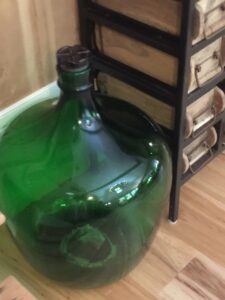 HT owns a thirty inch tall Demijohn, sometimes called a Dame Jeanne bottle, twenty inches in diameter. The vintage green glass bottle comes with a maroon glass stopper custom made for it because it fits perfectly. She put it in the garden where it gathered bird droppings, so after owning it 20 years she thought it time to clean it up. Her partner rigged a contraption with baby bottle brushes on poles to clean the beast. Now it’s gorgeous and perhaps rare because of its size, and with its own stopper extant. At one time we saw these huge bottles quite commonplace. Could YOU carry it filled with liquid?
HT owns a thirty inch tall Demijohn, sometimes called a Dame Jeanne bottle, twenty inches in diameter. The vintage green glass bottle comes with a maroon glass stopper custom made for it because it fits perfectly. She put it in the garden where it gathered bird droppings, so after owning it 20 years she thought it time to clean it up. Her partner rigged a contraption with baby bottle brushes on poles to clean the beast. Now it’s gorgeous and perhaps rare because of its size, and with its own stopper extant. At one time we saw these huge bottles quite commonplace. Could YOU carry it filled with liquid?
Let us go back to the 14th century when legend says Demijohns were invented, or I shall say first blown. Like so many origin myths, I know TWO valid versions.
Version One:
Glass blowers first made these bottles, which hold up to 50 liters, in a Persia town called Damaghian. Say the town’s name out loud to relieve your curiosity about how Demijohn got its name. A Demijohn, a bottle for liquor or oil, holds more than five modern bottles of wine or more. Demijohns, all of course hand blown, went all over the trade routes with liquor packed in straw or with wicker woven around the bottle itself.
Version Two:
The other myth, a more colorful story, involves Queen Jane of Naples (Joan I, 1326-1382), later Countess of Provence. In 1347 the King and Queen of Naples left their thrones and fled. Legend says this flight took place one stormy night, to the small town of Grasse in Provence. The first house they came to in the storm belonged to a glassblower, who gave them shelter for as long as they desired. During the visit, Queen Jane became interested in the process of blowing glass, asked to observe the lowly glassblower at work. The burgher felt nervous under the royal gaze. The little man blew and blew and blew the molten glass on the pontil rod. He inflated “the gather,” the amount of hot glass used to make a certain size bottle, he typically used to make a simple glass bottle to a massive translucent balloon size, with the skinny neck of his regular “blows.”
Queen Jane thought the huge blimp delightful, so the glassblower called the vessel The Queen Jane. Apparently the Queen, no longer a Queen, deferred to the name Lady Jane (Dame Jeanne). If you pronounce Dame Jeanne, pretending you’re French, you ALSO see where the name Demijohn originated.
Whatever story is correct
Designers love these bottles and place them in rustic but elegant settings. They can be worth, if older than the 1940s, around $600. The OLD ones, 19th century, sell for MUCH more. HT’s is 20th century. I see from the small size of the bubbles in the glass and the few imperfections that the technique of mouth-blown glass used was NOT the older style, usually seen with less clear, clean glass. Also the lip of the bottle has crimped edges made by a machine or a standardized tool, not hand “deadened,” another clue the bottle was blown post “machine age.”
We think of Spain and France as the historical center for blown Demijohn bottles, but any other country that imported liquor used them too. The online dictionary Wein Plus gives us the names these large beasts went by in various locations: Demi John, Demingnon, Lady Jane in England, Portugal, and Spain for the transport of sherry and Port. Damajuana in Argentina, Damigiana in Italy, and something improbable in the Low German Saxon Dialect’s name for a bottle used to transport brady and rum. Dame Jeanne in France.
Why do all Demijohns used to store and transport wine come in greens of various hues? Because wine et al naturally contains antioxidants, and sunlight decays the wine’s natural preservative. Sunlight also breaks down tannins, which also protects the wine. A deeply tinted glass stops sunlight, and green comes from the minerals in the sand used to make the glass in certain wine growing areas. The value of HT’s Demijohn is $400.